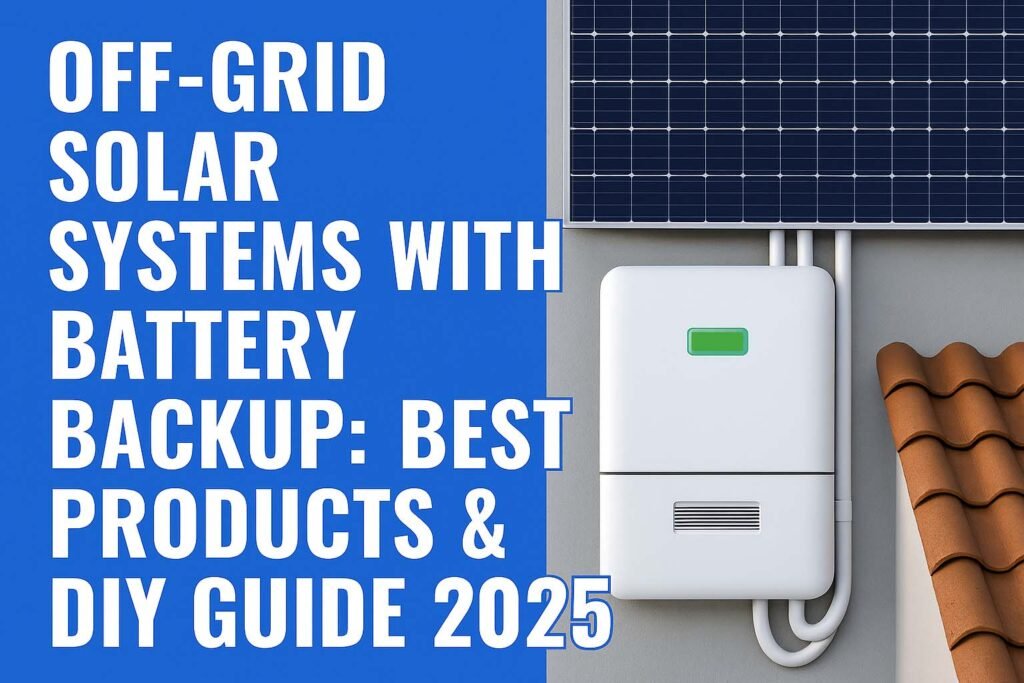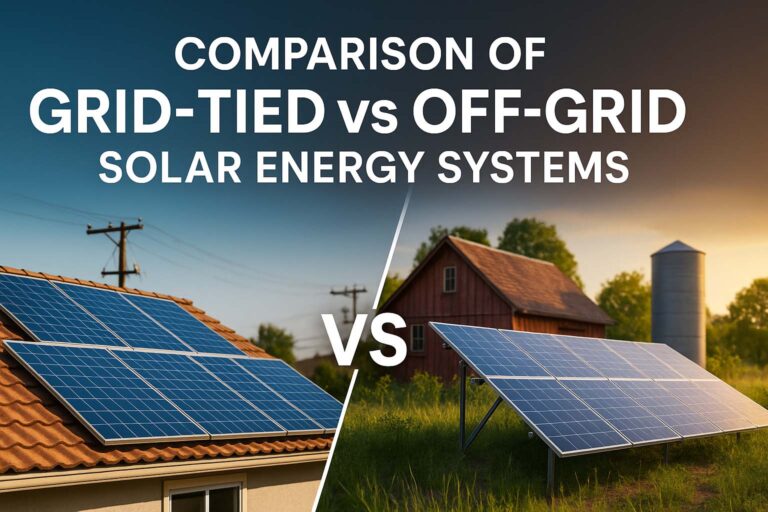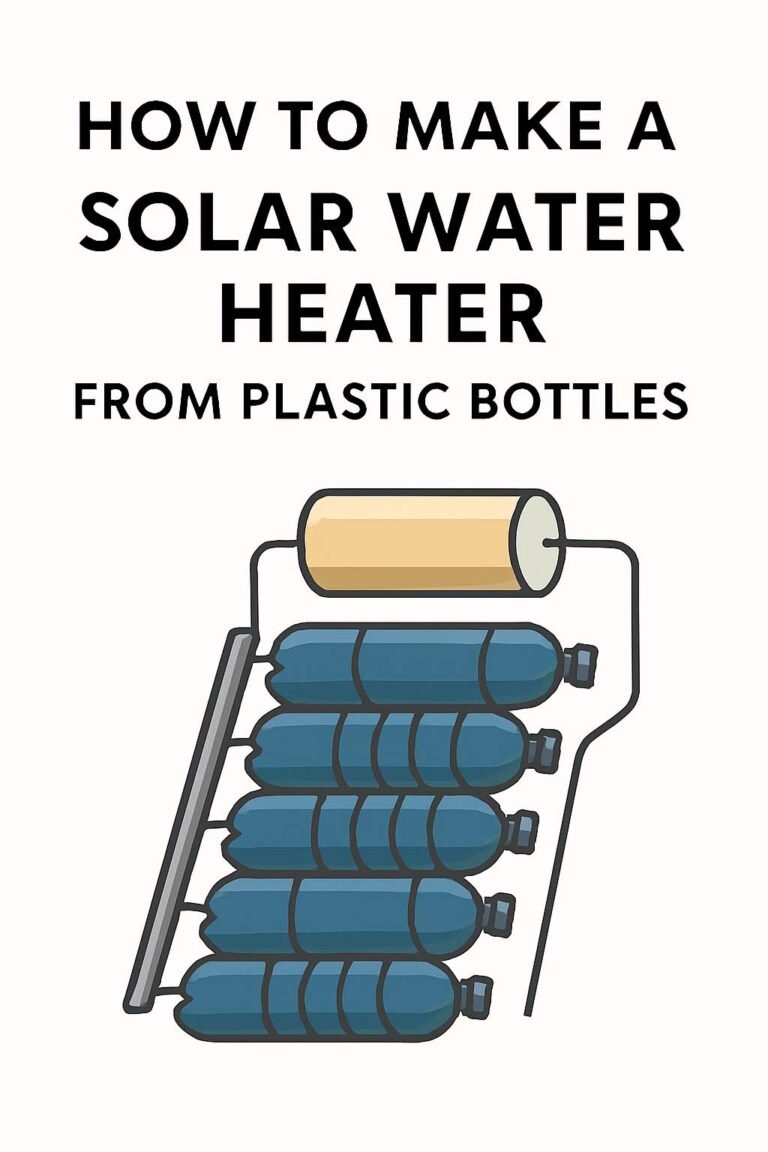Off-Grid Solar Systems with Battery Backup: Best Products & DIY Guide 2025
In 2025, more homeowners and businesses are breaking free from the grid. Rising energy prices, frequent power outages, and the push toward renewable living have made Off-Grid Solar Systems with Battery Backup a powerful solution. These systems let you store solar energy for night use and power your appliances without relying on the main utility grid. Whether you live in a remote cabin or just want energy independence, an off-grid setup gives you complete control over your power.
The idea is simple but transformative: solar panels collect sunlight, charge batteries through a charge controller, and an inverter converts that stored energy into usable AC power for your home. No more blackouts, no electricity bills—just reliable, clean energy on your terms.
Table of Contents
Table of Contents

In this guide, you’ll discover everything you need to know about Off-Grid Solar Systems with Battery Backup—the best products available in 2025, a step-by-step DIY installation guide, and expert insights to help you choose the right system for your needs.
Key Takeaways
- Off-Grid Solar Systems with Battery Backup provide full energy independence and reliable power storage.
- Top 2025 products include modular lithium battery systems and smart hybrid inverters.
- A proper setup can power homes, farms, or remote cabins year-round with minimal maintenance.
- DIY installation is possible with planning, accurate load calculation, and safety precautions.
Know more about Top Solar Inverters for Home Use: Engineering Comparison & Cost Guide 2025
Understanding Off-Grid Solar Systems with Battery Backup
An Off-Grid Solar System with Battery Backup works independently from the main grid. It uses solar panels to generate electricity, batteries to store it, and an inverter to supply household AC power. Unlike grid-tied systems, it doesn’t feed power back to the utility but instead focuses on self-sufficiency.
Here’s how the main components function together:
- Solar Panels: Convert sunlight into DC electricity.
- Charge Controller: Regulates battery charging to prevent overcharging.
- Battery Bank: Stores energy for night or cloudy days.
- Inverter: Converts DC power into AC power for household appliances.
When designed correctly, these systems can run everything—from lights and fans to refrigerators, air conditioners, and water pumps—completely off the grid.
Why Go for Off-Grid Solar Systems with Battery Backup in 2025
Energy independence is no longer a luxury; it’s a necessity. Power cuts, rising utility bills, and unpredictable weather make grid dependence risky. Off-Grid Solar Systems with Battery Backup allow you to live sustainably and cut your monthly energy costs to nearly zero.
Here are the major benefits in 2025:
- Energy Autonomy: Total control over your power supply.
- Savings Over Time: Initial costs are higher but offset by years of free solar energy.
- Backup Power: Batteries provide stored energy when the sun isn’t shining.
- Environmentally Friendly: Reduces your carbon footprint dramatically.
- Rural Accessibility: Perfect for areas where the grid doesn’t reach.
Many homeowners also use hybrid setups that can connect to the grid when needed. However, a pure off-grid system offers the highest level of independence and peace of mind.
Use our online tool Wire Size Calculator for Solar Panels – Avoid Power Loss in Off-Grid and Hybrid Systems
Top Off-Grid Solar Systems with Battery Backup in 2025
To help you choose the right system, here’s a detailed comparison of some of the best off-grid solar systems with battery backup available in 2025.
| Product Name | Battery Type | Storage Capacity | Inverter Power | Best For | Price Range (USD) |
|---|---|---|---|---|---|
| Tesla Powerwall 3 + Solar Kit | Lithium-ion | 13.5 kWh | 7.6 kW | Home & Small Office | $12,000–$16,000 |
| Bluetti EP800 Modular System | LiFePO₄ | Expandable (10–40 kWh) | 7.6 kW | Homes & Farms | $10,000–$15,000 |
| EcoFlow Power Independence Kit | LiFePO₄ | 5–20 kWh | 5 kW | RVs & Cabins | $7,000–$11,000 |
| Goal Zero Yeti Pro 4000 Kit | Li-ion | 4 kWh | 3 kW | Camping & Portable Use | $4,000–$6,000 |
| Growatt Off-Grid Solar Kit (SPF Series) | LiFePO₄ | 10 kWh | 5 kW | Small Homes | $8,000–$10,000 |
Each of these kits provides integrated components, remote monitoring apps, and efficient charge controllers. For long-term use, lithium or LiFePO₄ batteries are preferred for their cycle life, fast charging, and safety.
How to Size Your Off-Grid Solar System with Battery Backup
Before purchasing, you must calculate your daily energy consumption to size your system correctly. This ensures you get enough power without overspending.
| Appliance | Power (W) | Usage Hours/Day | Daily Energy (Wh) |
|---|---|---|---|
| LED Lights (10 units) | 10 | 5 | 500 |
| Refrigerator | 150 | 24 | 3600 |
| Ceiling Fan (3 units) | 70 | 8 | 1680 |
| TV | 100 | 4 | 400 |
| Laptop | 60 | 6 | 360 |
| Total | — | — | 6540 Wh (6.5 kWh) |
So, if you consume about 6.5 kWh per day, you’ll need around:
Know more about Floating Solar Panel Systems Design & Cost Analysis
- Solar panels: 2 kW capacity (for average sun hours).
- Battery backup: 10 kWh storage (for autonomy during nights).
- Inverter: 5 kW capacity (for peak load handling).
This setup ensures reliable day-night operation without grid support.
DIY Guide: Installing an Off-Grid Solar System with Battery Backup
Setting up your Off-Grid Solar System with Battery Backup is entirely possible as a DIY project if you’re technically inclined. Here’s how to do it safely and effectively.
Step 1: Site Assessment
Find a sunny spot for your solar panels with minimal shading. The roof or an open ground area works best.
Step 2: Mounting Solar Panels
Install panels on a mounting structure facing south (in the Northern Hemisphere) at an optimal tilt angle—usually equal to your latitude. Secure the structure to withstand wind and weather.
Step 3: Wiring the Panels
Connect the panels in series or parallel to match your inverter’s voltage rating. Use high-quality solar cables and MC4 connectors for safe, efficient connections.
Step 4: Installing the Charge Controller
Mount the charge controller close to the batteries. It ensures safe charging and prevents battery overcharge or deep discharge.
Know more about Off-Grid Solar System Design Guide for Remote Areas
Step 5: Setting Up the Battery Bank
Use lithium or LiFePO₄ batteries for better efficiency. Connect batteries in series for higher voltage or parallel for more capacity. Keep them in a well-ventilated, dry space.
Step 6: Connecting the Inverter
Connect the inverter to your battery bank and to your home’s electrical system. Make sure to include a proper fuse and disconnect switch for safety.
Step 7: Testing the System
Power up the system and check if everything works properly. Test solar input, battery charging, and AC output using a multimeter.
Safety Tip: Always wear insulated gloves, follow wiring diagrams, and, if unsure, consult a certified solar installer.
Maintenance Tips for Longevity
To make your Off-Grid Solar System with Battery Backup last longer, regular maintenance is key.
- Clean Panels Monthly: Dust and debris can reduce efficiency.
- Inspect Connections: Tighten loose terminals and check for corrosion.
- Battery Care: Avoid deep discharges below 20%.
- Firmware Updates: For smart systems like Tesla or Bluetti, update apps regularly.
- Temperature Control: Keep batteries away from direct sunlight or freezing temperatures.
With proper care, solar panels last 25+ years, and modern batteries can last over a decade with minimal degradation.
Cost Analysis and ROI
While initial setup costs can range from $8,000 to $20,000, the long-term returns are excellent.
| Cost Component | Estimated Range (USD) |
|---|---|
| Solar Panels (2–5 kW) | $3,000–$6,000 |
| Battery Bank | $4,000–$8,000 |
| Inverter & Controller | $1,000–$2,500 |
| Installation & Accessories | $1,000–$3,000 |
| Total | $8,000–$20,000 |
The ROI period is typically 5–7 years, depending on your energy savings and local sunlight availability. After that, it’s nearly free power for decades.
Best Use Cases in 2025
- Rural Homes: Ideal where utility grids are unreliable.
- Cabins and RVs: Power your lifestyle anywhere you travel.
- Emergency Backup: Keep essential loads running during blackouts.
- Agriculture and Farms: Run pumps and lights without diesel generators.
As energy storage technology improves, expect more compact, efficient, and AI-controlled systems by late 2025.
Know more about MPPT vs PWM Charge Controller: Which One is Better?
Final Thoughts
An Off-Grid Solar System with Battery Backup is not just about saving on bills—it’s about freedom and sustainability. With modern lithium technology, smart monitoring, and efficient solar panels, living off the grid has become easier than ever.
If you’re considering going solar this year, start by calculating your daily energy needs, choosing a reliable kit, and following a safe installation plan. Whether you build it yourself or hire a professional, the result is the same—energy independence and a cleaner future.
In 2025, off-grid living isn’t just a dream. It’s a smart investment for homeowners, adventurers, and anyone ready to take control of their power.
Follow Us on Social:
Subscribe our Newsletter on Electrical Insights to get the latest updates in Electrical Engineering.
#OffGridSolarSystems, #SolarBatteryBackup, #DIYOffGridSolar, #SolarPower2025, #RenewableEnergy, #SolarEnergySolutions, #HomeSolarSystem, #SolarPanelsWithBattery, #EnergyIndependence, #OffGridLiving, #SolarSetupGuide, #BestSolarProducts, #SustainableEnergy, #GreenPower, #SolarInstallation




